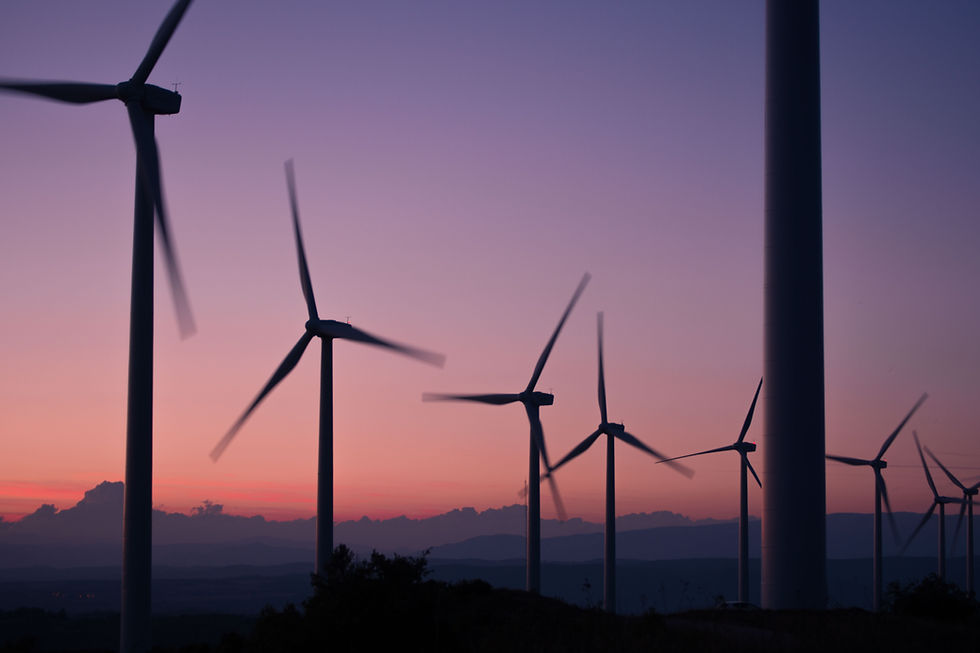Wave Farms and Current Turbines
- Taylor Napier
- Sep 11
- 4 min read

Will Marine Energy Find Its Place in the American Energy Landscape?
As far as hot topics go, energy is always one of them. From “drill baby drill” to “powering a sustainable future” to “harnessing nature’s energy,” we’ve got power on our minds. Despite shifting regulatory and policy support for renewable energy development and implementation, investment in innovation is growing, technology continues to create new possibilities, and startups are honing prototypes that consider regional needs as much as global targets.
Here in the United States, solar energy development is on the rise, but globally, hydropower is responsible for half of the world’s renewable energy. The ocean is a relatively untapped source of energy production. Harnessing power created by waves and currents, in theory, could generate upward of 60% of the world’s energy. Can marine energy find a place in our American energy landscape?
Goals and Metrics for Renewable Energy Success
If slogans underscore energy goals, then there are a lot of directions we can go. Is net zero the goal? Or, making sure that no region of the United States is overly dependent on another region for energy? We know the movement of water in the ocean is capable of producing a lot of energy, so perhaps we have an obligation to harness known renewable sources. And, if we consider that agriculture is moving offshore, it is reasonable to think that marine energy could be an instrumental component of aquaculture infrastructure.
Where net zero is the goal, the metrics of economic, social, and environmental impact, and technical variables will flesh out differently than if the goal is simply to supply a typically cloudy, non-solar-friendly, coastal area with renewable energy options. Tidal energy might be the most effective along the coasts of Alaska, but the more ideal cost versus benefit ratio might be along the Atlantic coast or the canals of Florida. Designs that work well in the Pacific Northwest might not hold up against hurricane season along the Gulf Coast.
Developers consider how new technology can bring business to a region and add jobs. They consider how marine life could be impacted by water turbines. How long can a turbine last? Where in the United States is water movement reliable and consistent? Is the method of harnessing water power scalable or only appropriate to one region? It's these kinds of questions that have presented challenges for the marine energy industry.
Challenges Faced by Wave Farms
Salt is the most obvious challenge when we think about placing machines in the water. Corrosion, rust, and the general breakdown of equipment left in ocean water jeopardize the lifespan of much of this technology, and even startup companies with solid designs capable of converting currents into power have folded under the financial strain of maintaining equipment in saltwater environments. True durability has been difficult to assess, as most prototypes are tested in wave pools that can’t replicate a bomb cyclone.
Beyond the physical challenges presented by saltwater and severe weather, the marine energy industry has faced financial challenges. Because tidal energy is largely still in the research and development phase, it is considered a high-risk financial investment. And, upfront development costs are high for everything from materials to securing time in wave pool testing facilities to getting equipment out for actual ocean assessment. Integrating new technologies with existing power grids can also be costly.
Where Will Marine Energy Fit In?
Marine energy may not overtake solar energy here in the United States anytime soon. However, we don’t have to take the perspective of swapping one form of energy for another. Perhaps truly sustainable energy models incorporate multiple sources and leverage both renewable and non-renewable options.
All over the world, developers are looking at existing offshore wind turbine farms as prime locations for wave farms. Could wind and wave energy both be farmed in the same location? If so, it's possible some of the costly logistical and technological challenges could be streamlined. But, more importantly, the combination could add a layer of security to power grids.
In South Africa, a model combining one wind turbine, five wave turbines, and a diesel generator is having great success. Through the lens of sustainability, this could be an optimized combination that relies on renewable energy but is backed up by fossil fuels.
In Europe, where funding is somewhat fragmented, the industry has focused on leveraging marine energy for small-scale energy needs. Remotely located communities and industries are benefiting from harnessed water power. The goal isn’t to find the strongest power source, but rather, a consistent power source. That puts lakes, rivers, and inlets in the running as potential power sources for non-utility-sized needs.
Japan installed a tidal turbine in its Naru Straight as part of its national goal to decarbonize. The turbine is intended to supply the Goto Islands with electricity. Japan is an ideal location for large-scale marine energy production due to the fact that its coastal currents are consistently strong. Canada, France, and the UK all have similarly ideal regions, which means the British turbine positioned on the Japanese coast has the potential to be usable around the world.
In the United States, the Mississippi River is home to two twelve-foot-diameter turbines that developers believe could operate indefinitely as long as the river continues to run. The turbines have been added to an existing dam structure and integrated into the existing power grid. Unlike ocean currents, the Mississippi is free of corrosive saltwater. Hydropower also made the list of preferred energy alongside geothermal, biomass, coal, oil, and gas. Sourcing energy from water flow made the cut because it has the capability to generate around-the-clock energy 365 days a year. If reliability and consistency are the most important priorities when considering energy investments, then marine power is sure to make slow and steady progress as it gains a footing in the energy landscape.




Comments